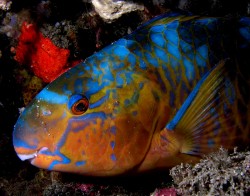
Parrotfish on North coast of East Timor. Photo: Nick Hobgood/Wikipedia.
If you love sausages, you should never try to find out how it is made. The same applies to many other things as well. If you love the idea of sunbathing in the Caribbean, you should consider skipping this post.
Biogenic or coral sands found on the seashores of tropic beaches are largely composed of bits and pieces of coral, calcareous algae, foraminifera, gastropoda, sea urchins, etc. Much of this material was rasped from the coral reefs by brightly colored parrotfish. They grind the pieces of corals which then goes through their digestive system to get deposited on the shallow seafloor as calcareous sand grains.
Most parrotfish actually do not feed on corals. They are looking for algae that are inhabiting coral reefs. One might think that parrotfish are a threat to the coral reef ecosystem but it is not true. They actually help corals by not letting algae to choke them.
Parrotfish are very important agents of bioerosion. One parrotfish can make 90 kg of coral sand a year. Parrotfish depend on coral reefs just as coral reefs depend on them. Coral reefs in many parts of the world are not doing well recently, and the same applies to parrotfish as well. They are not seriously endangered, but the future with overfishing, global warming, pollution, and ocean acidification promises not much good to them.
Here is a short video of sandmaking process:
Leave a Reply